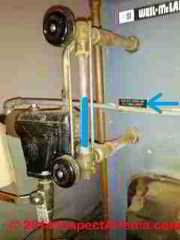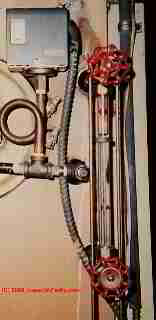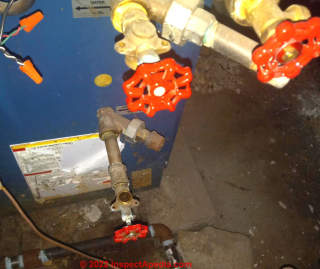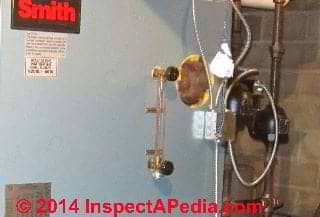 Steam Boiler Sight Glass
Steam Boiler Sight Glass
How to use the sight gauge to set the water level steam boiler
- POST a QUESTION or COMMENT about the sight glass on steam boilers
Steam boiler sight glass:
This article describes how to find & use the sight glass (or sight gauge) on a steam heating boiler to check or set steam boiler water level.
We explain where the sight glass will be found, how to read its water level, and the relationship between the sight glass reading and the procedure for adding make-up water to the boiler.
InspectAPedia tolerates no conflicts of interest. We have no relationship with advertisers, products, or services discussed at this website.
- Daniel Friedman, Publisher/Editor/Author - See WHO ARE WE?
Guide to the Steam Boiler Sight Glass
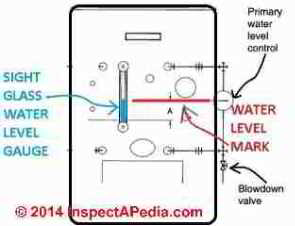
The steam boiler sight glass or water level gauge allows the building owner or maintenance person to monitor the required water level in the steam boiler.
A mark on the boiler body indicates the desired normal water level and a sight glass shows the current water level.
[Click to enlarge any image]
Steam systems use varying amounts of water. Unlike a hydronic heating boiler, some of the water in the steam boiler is lost through the building's radiator steam vents at each heating cycle.
Just how much water the steam boiler will lose varies widely depending on a number of factors.
But if a heating boiler loses its water without also being shut down it will certainly be damaged by the heat of the oil or gas burner (or coal or wood), and it could lead to a dangerous explosion or fire.
Watch out: The sight glass on a steam boiler is an important safety and operating device since it allows the homeowner or inspector to see at a glance when the steam boiler is low on water.
For boilers that lack an automatic water feeder, the steam boiler water level needs to be checked regularly (typically at least once a week) to assure adequate water and safe boiler operation.
Low water in the boiler will lead to loss of heat or possibly an unsafe condition that can lead
to BLEVE EXPLOSIONS.
Most modern steam boilers are protected against catastrophic water loss by
With a LWCO installed, if water level drops too low in the boiler the valve will shut down the burner - turn off your heat.
Our photo below shows the steam boiler sight glass or water level gauge on a Weil McLain Model 68 steam boiler.
Our blue arrow shows the tag or mark on the boiler jacket indicating the desired water level, while the vertical blue line I drew on the sight glass shows where the water level should be.
Watch out: just as you don't want too little water in the steam boiler you also don't want to over-fill the boiler. Doing-so may prevent steam from rising to the building.
How to Read the Steam Boiler Water Level through the Sight Glass
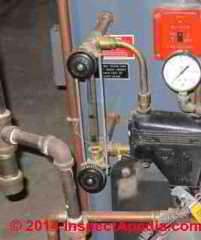 The boiler sight gauge should be installed so that the lowest visible part of the gage glass itself is at least 1-inch above the primary LWCO (Low Water Cutoff Control).
The boiler sight gauge should be installed so that the lowest visible part of the gage glass itself is at least 1-inch above the primary LWCO (Low Water Cutoff Control).
Acceptable water level: The boiler sight gauge should be installed so that the lowest visible part of the gage glass itself is at least 1-inch above the primary LWCO (Low Water Cutoff Control).
When the water level is below the indicator mark on the sight glass gage (or possibly on a line provided on the body of the boiler behind or close to the sight glass) the boiler may still be safe to operate - as long as you can see water.
Typical manufacturer's instructions: a water level anywhere 4-inches above the bottom of the sight gauge and below the top of the glass area of the gauge will be just fine.
Watch out: if the water level in the sight glass disappears completely the boiler is unsafe (and may damaged as well) and should be shut down.
How to check the sight glass gage water level: Details
The following instructions are from Superior Boiler Works, cited below. Instructions for your specific boiler may vary.
The required frequency [ with which you need to check the boiler water level ] must be determined by trial. The check should be made when there is steam pressure on the boiler. Close the lower gage glass valve, then open the drain cock which is on the bottom of this valve, and blow the glass clear.
Close the drain cock and open lower gage glass valve. Water should return to the gage glass immediately. If water return is sluggish, leave the lower gage glass open and close the upper gage glass valve.
Then open the drain cock and allow water to flow until it runs clear. Close the drain valve and repeat the first test described, with the lower gage glass valve closed. If leaks appear around the water gage glass or fittings, correct the leaks at once.
Steam leaks may result in a false waterline and they also may damage the fittings.
If water disappears from the water gage glass, blow down gage glass (described in previous paragraph) then water column to see if water appears.
If it does not appear, then stop the fuel supply immediately. Do not turn on the water feed line. Do not open the safety valve. - Superior Boiler Works
Normal vs. abnormal Surging of Water in the Sight Glass
Modest fluctuation of water level in the sight glass is normal, but if you see wide fluctuation - an inch or more - then the boiler may be foaming or priming, or the water level in the boiler may have been set too high.
Foaming is caused by dirt or oil in the boiler water - the boiler may need cleaning, but foaming might be stopped by allowing the boiler to cool down completely (turn off the burner), and then removing pressure (blowing the boiler down), draining the boiler at its service drain and refilling it two or three times.
But if foaming continues then the boiler needs to be professionally cleaned.
You may also notice that when feeding water into the boiler automagically or by manual valve the water level surges in the sight glass.
Just wait a moment for the surging to stop before making your water level reading. If surge is excessive you might try slightly closing the bottom inlet valve on the glass but be sure not to close it fully or you'll get no reading at all.
In fact if you are putting water into the boiler and the level in the sight glass does not move, I'd wonder if one or both of the sight glass control valves were shut or debris-clogged.
The photo above with our blue markings shows a typical mark on the steam boiler indicating the desired boiler water level. Some steam boiler sight glass gauges will sport two index marks: a low-water mark and a high-water-level mark.
The boiler water level needs to be maintained between these two levels. You will see two such marks on the steam gauge with red control valve handles earlier on this page.
The photo at left has two black marks drawn right on the sight glass indicating where the building manager wants water level maintained.
On this steam boiler installed in Portland Maine, the black data tag found boiler near the top of the sight glass has these instructions:
Minimum Water Level 4" above the bottom of the gauge glass.
A reader asked us if she should read the water level in the steam boiler gauge glass using the top edge of the water or the bottom edge of the curve that's observed on water in any vertical tube. Don't worry about reading the water level or matching it to the boiler line with high precision.
If you are off a half of an inch the boiler won't care.
In the Portland Maine boiler photo shown above, I would ignore those black magic marker indicators somebody drew on the sight glass and follow the manufacturer's instructions.
When & How Much Water to Add to the Steam Boiler
If your steam boiler has an automatic water feeder you should see the water level always close to the fill-mark and the automatic water makeup valve will normally do this job for you.
When to add water to the steam boiler
If your steam boiler has only a manual valve for adding water, until you know the system's rate of water usage, you should check the water level at least once a week during the heating season.
You'll want to add water whenever the sight glass shows that the water level has dropped to the "add" mark and you should always see some water in the sight glass.
How much water to add to the steam boiler
The sight glass on a steam boiler, combined with a mark or gauge usually placed on the sight glass or on the boiler body behind the glass, will show the proper level to which the steam boiler should be re-filled when it's low on water.
How do I add make-up water to a steam boiler
The answer is, it depends. If your boiler has an automatic water feeder it should be doing the job for you and all you need to do is check the boiler water level periodically.
If your boiler has only a manual water feed valve you'll need to follow a series of easy steps to check water level and to bring boiler water level to the proper index mark checked against the sight glass.
Watch out: if water is not visible in the sight glass, turn off the burner immediately, then continue to feed water into the steam boiler slowly until water reaches the level indicated at the sight glass. Don't feed cold water rapidly into a hot boiler or it may be damaged or even ruined.
Note: this discussion is for using the sight glass and maintaining the proper water level in steam boilers. Hot water (hydronic) heating system boilers do not normally use a sight glass because those boilers and the entire hot water piping, radiators, baseboards, etc. are normally always filled with water - these are "flooded systems".
Details of these water feeding procedures for steam boilers are
Steam Boiler Sight Glass Leaks, Breaks, Repair
- Please see STEAM BOILER SIGHT GLASS REPLACEMENT for steps in repairing or replacing a leaky or broken steam boiler sight gauge or sight glass.
These heating boiler leak diagnostic articles may also help troubleshoot steam boiler sight glass crud or leaks:
- CONDENSATE RETURN PIPES, PUMPS, STEAM - steam systems
- ECR OIL FIRED STEAM BOILER HEAT EXCHANGER REPLACEMENT & LWCO PROBE RELOCATION [PDF] Series 4 - Series 5 Conversion Instructions
- LEAKS at BASEBOARD, CONVECTOR, RADIATOR - hot water heat: how to find leaks at baseboards, radiators
- BOILER LEAKS CORROSION STAINS - how to diagnose & evaluate leaks on or in heating boilers
- BOILER LEAKS, HOW TO LOCATE - how to determine that a boiler or hot water system is leaking and how to find hidden leaks
- Superior Boiler Works, SCOTCH MARINE FIRETUBE STEAM BOILER MANUAL [PDF] 3-Pass & 4-Pass Wetback High & Low Pressures 40 - 2500 BoHP Gas / Oil / Gas & Oil - Superior Boiler Works, Inc 3524 E. 4th Avenue Hutchinson, KS 67501 USA, Tel: (620) 662-6693 Web: www.superiorboiler.com
Steam Boiler Sight Glass Water Too High
Question: sight glass fills too high on Utica gas furnace
(Jan 28, 2015) Bob said:
Utica gas furnace 1986, Auto Feed, sight glass continues to fill beyond fill line. Why?
Reply:
Leak into the boiler from a tankless coil, faulty water feed valve, clogged ports into or out of the sight glass, or the steam boiler is actually flooding:
See STEAM BOILER FLOODING / SURGING REPAIRQuestion: High water level in the steam boiler sight glass
(Nov 29, 2015) Alan said:
Water level in steam boiler is more than 3/4 in the site glass, when I turn boiler on after few minutes calls for water green light on the automatic feeder gone on, water gets in and fills the glass stops then after few minutes automatic feeder gose on agin even though the water level is passing the site glass, Lwco float works good, and lwco is clean.
If I leave the automatic feeder on I have to drain the boiler many times a day , boiler and radiators have no leak. Never maintained the ITT McDonnell and miller UNI- MATCH on my boiler. Now I have the boiler on Manuel feed' I disconnected power to the water feeder. Any suggestion? Thanks
Reply: common sources of water feed valve trouble
Alan
Review the cleaning instructions in the instructions for the water feed valve. Chances are it is debris clogged.
Alan said:
Thanks Mod, I will review feeder's instruction. Well terminal 1 on the lwco McDonnell & Miller 67 switch is fed by neutral from the other side of the burner, terminal 2 is fed by hot power controlled by the thermostat. Water feeder ITT McDonnell and miller UNI- MATCH terminal 2 neutral strait from transformer, terminal 3 hot power from terminal 2 ON LWCO.
I cleaned the float and is moving well when the boiler is on I checked it visually when I drained the boiler using lwco handle. Burner goes off when lwco is drained which is good. Terminal 3&4 on lwco switch is left alone. Are these connections good. Any feed back guys, thanks
(mod) said:
While a control can fail and need replacement, often steam boiler LWCO and water feed problems are traced to a clogged strainer or screen in the device or sludge that has blocked a float. You've addressed the second item; check the maintenance drill to be sure we haven't missed the first one.
Below see the live link for STEAM BOILER FLOODING REPAIR
Steam Boiler Sight Glass Water Level Too Low
When the water level is below the indicator mark on the sight glass gage (or possibly on a line provided on the body of the boiler behind or close to the sight glass) then the water level is "low".
Watch out: if the water level in the sight glass disappears completely the boiler is unsafe (and may damaged as well) and should be shut down.
The most-common causes of water disappearing from the boiler sight gauge glass are
- Automatic water feeder valve not working
- Check-valve inoperative
- Condensate return lines clogged, condensate return to the boiler is slowed
- Vacuum-breaker inoperative
- Incorrect Hartford Loop Piping
If the automatic water feeder is not keeping water at the proper level in your heating boiler, or if a low water cutoff LWCO safety control is not responding when water level in the boiler is too low, the heating system is unsafe and should be shut off and repaired to avoid boiler damage.
Watch out: do not allow a boiler to continue to run if it is too low or has run out of water. LWCOs are among multiple heating system safety controls that help prevent
boiler BLEVE EXPLOSIONS.
For boilers using an automatic water feeder valve, the most-common cause of low boiler water level is failure to properly clean and maintain the water feeder valve, and the most-common cause of failure of the LWCO safety control to function is the same: failure to clean and flush the valve using the "blow-down valve" as specified by the manufacturer.
See details at LOW WATER CUTOFF VALVE.
At LOW WATER CUTOFF VALVE NOT WORKING we describe the steps recommended by Hydrolevel if that company's CycleGard LWCO is not responding properly to low water levels in the boiler.
Questions: Water level too low or not visible in the sight glass / steam boiler doesn’t cut off when the water level falls
2019/02/07 ISAAC said:
When boiler fire the water in the sight glass drops all the way down one pipe system Weil McLean
2019/02/10
Stafford said:
My steam boiler doesn’t cut off when the water level falls to a point where I can not see it the light donesn’t come on on it a manual feed and a cycle guard low water cut off middle CG450
Reply:
Stafford,
What to do when the HydroGard LWCO does not shut off the boiler at low water condition
Watch out: Thank you for asking Stafford, as you've touched on a very important safety feature designed to avoid boiler damage, desctruction, or even more-dangerous conditions.
It appears that your CycleGard Low water cutoff LWCO is not working, perhaps needing sensor cleaning or, less likely, replacement of the control.
Periodic maintenance is needed to keep this LWCO working properly.
At LOW WATER CUTOFF VALVE NOT WORKING we repeat your question and give a detailed answer giving the steps to follow when a Hydrolevel CycleGard LWCO isn't responding to low water in the boiler.
Please read the details there and let me know what questions remain.
...
Reader Comments, Questions & Answers About The Article Above
Below you will find questions and answers previously posted on this page at its page bottom reader comment box.
Reader Q&A - also see RECOMMENDED ARTICLES & FAQs
On 2022-12-18 by Simon - can the steam boiler run without the sight glass in place?
I was told by a technician that my steam boiler can be ran without the sight glass attached, is that true because he left the boiler running when he left.
On 2022-12-18 by InspectApedia (Editor) - can the steam boiler be run without the sight glass attached
@Simon,
Yes that's true, as long as the two control valves at the top and bottom of the sight glass have been turned off the boiler will run fine, without leaks.
But
Watch out: without the sight glass you have no way to see whether or not there is a low-water problem in the boiler.So you will want that sight glass replaced promptly as a step in avoiding costly boiler damage should other controls (automatic water feeder and low water cutoff) fail and the boiler water level fall too low.
On 2022-12-10 by Shirleu - do we keep sight glass valves open or closed?
There are 2 valves above the sight glass.......should these valves be open or closed.
On 2022-12-10 by InspectApedia (Editor)
@Shirleu,
Normally a steamboiler site glass has a valve installed above and below the cylinder or sight glass tube, so I'm not sure what the 2 above are in your case.The sight glass valves are kept open unless there is a leak.
Perhaps you can post a photo.
On 2022-11-27 by Robert Davis - open the steam boiler sight glass knobs fully?
the handles on the sight glass upper and lower should they be opened all the way?
On 2022-11-28 by InspectApedia (Editor)
@Robert Davis,
Normally, yes.
If the boiler is surging the system may need cleaning. Closing the sight glass valves isn't really a fix.
On 2022-11-21 by Jillie - why doesn't boiler water level change?
My water level hasn't moved at all in the past few months (we just turned on our heat, but months ago I was still checking and adjusting as needed, even with the heat off) and now the water in the sight looks yellowish!
Water coming out the tap doesn't look discolored. Is this just sediment from the off season that will work itself out as we use more heat, or should I be worried and get my plumbers on the line?
On 2022-11-21 by InspectApedia (Editor) - common for some sediment to develop in steam boilers
@Jillie,
The water that comes out of your TAP at a sink or tub is the water that is fed INTO the boiler.
However the water that's IN the boiler has nothing further to do with the house Plumbing system.
It's common for some sediment to develop in steam boilers, and the steam boiler needs periodic maintenance including regular flushing of its low water cut off valve.
If you're not already doing that you should have your heating service person inspect and clean the system and show you how to perform that homeowner task.
Otherwise you may lose heat or your boiler could become unsafe.
On 2022-11-08 by Katie - yellow and the green light is lit on the boiler indicator which tells when you need water
Both the yellow and the green light is lit on the boiler indicator which tells when you need water. the automatic water feeder is malfunctioning
the boiler is leaking in the back on the bottom
On 2022-11-08 by InspectApedia (Editor) - boiler is leaking in the back
@Katie,
It sounds as if we are talking about a steam boiler water feed valve not the sight glass discussed on this particular page. If you can identify the brand and model of your water heater feeder valve we can be sure to point you to the proper explanation of this light and functions.Look closely at the leak but don't poke at or wiggle anything as if the boiler is rusted or damaged you may turn a slow leak into an immediate flood catastrophe.
If the leak is from a tapping, fitting, or valve it's probably an easier repair. If the leak is from a rusted through or cracked boiler then it's time for a new boiler.
On 2022-09-09 by Mike - where to put the friction rings in the steam boiler sight glass
In what order do the Friction rings go in the sight glass
On 2022-09-12 by InspectApedia-911 (mod) - what order do the friction rings go in the sight glass
@Mike,
Using a typical installation instruction such as for the Electr-Steam boiler, here is the order:
FIRST: Slip a rubber washer onto the sight glass gauge
THEN:
Slip the following items through the top of the glass gauge (tube) in this order:
1. Friction Washer
2. Glass Packing Nut (facing down)
3. Glass Packing Nut (facing up)
4. Friction Washer
5. Rubber Washer
The gasket or O-ring has to go inside of the packing nut, so the way I install these is to slide the packing nuts over the top and bottom of the sight glass, then push an O-ring over the sight glass top and bottom, then assemble that into the holding and valve fittings before tightening.
When tightening the packing nut the o-ring or gasket compresses to snug up against the glass to avoid leaks. Don't tighten so much as to break the glass.
At SIGHT GLASS REPLACEMENT
you will see detailed instructions as well as downloads of installation manuals and gauges for boiler sight glass products.
THANK YOU for a most helpful question
On 2021-11-25 by Steve - what water level should we see in the sight glass, and when?
Regarding your article on Boiler water level: Should the level indicated on the boiler correspond to a level when the boiler is off, or should that be the level when the boiler is on and running ?
A technician told me to ignore the water level on the HB Smith boiler cabinet and use the mark on the low water casing (which is quite a bit lower). He advised to not add water, but to let the system add water when it dropped below the low water level.
The problem with this approach is that when the system is running, the water level drops below the low water mark and the automatic low water feeder (float) adds water. When the condensate returns to the boiler, the level is quite a bit higher than the mark on the low water casing.
So, I believe he is wrong. Also, when the water level gets less than @ 1/3 on the site glass, a water hammer occurs . This does not seem to occur if the water level (when the boiler is off) is near or at the top of the sight glass. Your advice please.
On 2021-11-26 by Inspectapedia Com Moderator - delay in the return of condensate to steam boiler
@Steve,
Thank you that's really helpful question. If I've got this right I think the underlying problem is that there is a delay in the return of condensate to your steam boiler.
So we have two problems to avoid. If we overfill the steam boiler than you could lose steam or the system may not work properly. On the other hand if during operation the level of water in the boiler Falls considerably too low there is a risk of damage or even an unsafe heating boiler.
Your heating service tech is probably right, but you might want to discuss with him or her the question of being absolutely sure that the boiler water level never falls so low that it is unsafe or that there's risk of damage to the boiler.
You might also explore the question of whether or not the condensate return rate your system is improperly slow, as could happen if there's a partial blockage in the condensate return piping.
...
Continue reading at SIGHT GLASS REPLACEMENT or select a topic from the closely-related articles below, or see the complete ARTICLE INDEX.
Or see SIGHT GLASS, STEAM BOILER FAQs - questions & answers about using, adjusting, cleaning, or fixing the steam boiler sight glass, originally posted at this article
Or see these
Recommended Articles
- BOILER CLEANER CHEMICALS / TREATMENTS
- BOILER LOW WATER CUTOFF CONTROL LWCO MANUALS
- LOW WATER CUTOFF VALVE, BOILER
- LOW WATER CUTOFF VALVE NOT WORKING
- LOW WATER CUTOFF CONTROL MANUALS
- SIGHT GLASS, STEAM BOILER
- STEAM BOILER FLOODING / SURGING REPAIR
- STEAM BOILERS GENERATORS CONTROLS, PRATT for some interesting history of steam generators & steam turbines.
- STEAM HEATING SYSTEMS & CONTROLS - home
- WATER FEEDER VALVE, HYDRONIC BOILER - forced hot water heat
- WATER FEEDER VALVE, STEAM - steam heat: yours is a steam boiler
Suggested citation for this web page
SIGHT GLASS, STEAM BOILER at InspectApedia.com - online encyclopedia of building & environmental inspection, testing, diagnosis, repair, & problem prevention advice.
Or see this
INDEX to RELATED ARTICLES: ARTICLE INDEX to STEAM BOILERS
Or use the SEARCH BOX found below to Ask a Question or Search InspectApedia
Ask a Question or Search InspectApedia
Try the search box just below, or if you prefer, post a question or comment in the Comments box below and we will respond promptly.
Search the InspectApedia website
Note: appearance of your Comment below may be delayed: if your comment contains an image, photograph, web link, or text that looks to the software as if it might be a web link, your posting will appear after it has been approved by a moderator. Apologies for the delay.
Only one image can be added per comment but you can post as many comments, and therefore images, as you like.
You will not receive a notification when a response to your question has been posted.
Please bookmark this page to make it easy for you to check back for our response.
IF above you see "Comment Form is loading comments..." then COMMENT BOX - countable.ca / bawkbox.com IS NOT WORKING.
In any case you are welcome to send an email directly to us at InspectApedia.com at editor@inspectApedia.com
We'll reply to you directly. Please help us help you by noting, in your email, the URL of the InspectApedia page where you wanted to comment.
Citations & References
In addition to any citations in the article above, a full list is available on request.
- [1] Power Technology and Engineering (formerly Hydrotechnical Construction), Volume 43, Number 4, 247-250, DOI: 10.1007/s10749-010-0105-4 - Thermal Power Stations, Temperature regime for damaged steam superheater coils, V. A. Bogachev (this is a PDF file - if you can't find contact SpringerLeak)
- [2] "Deaerator", Wikipedia, web search 12/18/11. Quoting:
The deaerators in the steam generating systems of most thermal power plants use low pressure steam obtained from an extraction point in their steam turbine system. However, the steam generators in many large industrial facilities such as petroleum refineries may use whatever low-pressure steam is available. - [3] Babcock & Wilcox Co. (2005). Steam: Its Generation and Use (41st ed.).
- [4] Thomas C. Elliott, Kao Chen, Robert Swanekamp (coauthors) (1997). Standard Handbook of Powerplant Engineering (2nd edition ed.). McGraw-Hill Professional. ISBN: 0-07-019435-1.
- Weil McLain Model 78 Boiler Manual, Boiler for gas, light oil, Gas/Light Oil fired Burners, Installation, Start-up, Parts, Maintenance instructions, Part No. 550-141-705/0600, Weil-McLain Administrative Office, 999 McClintock Drive, Suite 200, Burr Ridge, IL 60527
Tel: 855-248-1777
Consumer Inquiries: 800-368-2492
Technical Services: 800-526-6636 Technical Support for Contractors Only.
If you are a homeowner and are experiencing a problem with your Weil-McLain equipment, the first step you must take is to contact your installer or locate an HVAC contractor in your area. Website: http://www.weil-mclain.com - Bell & Gossett Air Separators and other heating system components, Bell & Gossett, 8200 N. Austin Ave., Morton Grove IL 60053, USA - Tel 847 966-3700 Fax 847 965-8379.
- Thanks to Bottini Fuel service manager Ron Thomas for discussing aquastat functions, low limit controls, oil burner short cycling causes, and boiler maintenance, reliability, and service contracts 4/13/2010. Bottini Fuel is a residential and commercial heating oil distributor and oil heat service company in Wappingers Falls, NY and with offices in other New York location
- Domestic and Commercial Oil Burners, Charles H. Burkhardt, McGraw Hill Book Company, New York 3rd Ed 1969.
- National Fuel Gas Code (Z223.1) $16.00 and National Fuel Gas Code Handbook (Z223.2) $47.00 American Gas Association (A.G.A.), 1515 Wilson Boulevard, Arlington, VA 22209 also available from National Fire Protection Association, Batterymarch Park, Quincy, MA 02269. Fundamentals of Gas Appliance Venting and Ventilation, 1985, American Gas Association Laboratories, Engineering Services Department. American Gas Association, 1515 Wilson Boulevard, Arlington, VA 22209. Catalog #XHO585. Reprinted 1989.
- The Steam Book, 1984, Training and Education Department, Fluid Handling Division, ITT [probably out of print, possibly available from several home inspection supply companies] Fuel Oil and Oil Heat Magazine, October 1990, offers an update,
- Principles of Steam Heating, $13.25 includes postage. Fuel oil & Oil Heat Magazine, 389 Passaic Ave., Fairfield, NJ 07004.
- The Lost Art of Steam Heating, Dan Holohan, 516-579-3046 FAX
- Principles of Steam Heating, Dan Holohan, technical editor of Fuel Oil and Oil Heat magazine, 389 Passaic Ave., Fairfield, NJ 07004 ($12.+1.25 postage/handling).
- "Residential Steam Heating Systems", Instructional Technologies Institute, Inc., 145 "D" Grassy Plain St., Bethel, CT 06801 800/227-1663 [home inspection training material] 1987
- "Residential Hydronic (circulating hot water) Heating Systems", Instructional Technologies Institute, Inc., 145 "D" Grassy Plain St., Bethel, CT 06801 800/227-1663 [home inspection training material] 1987
- "Warm Air Heating Systems". Instructional Technologies Institute, Inc., 145 "D" Grassy Plain St., Bethel, CT 06801 800/227-1663 [home inspection training material] 1987
- Heating, Ventilating, and Air Conditioning Volume I, Heating Fundamentals,
- Boilers, Boiler Conversions, James E. Brumbaugh, ISBN 0-672-23389-4 (v. 1) Volume II, Oil, Gas, and Coal Burners, Controls, Ducts, Piping, Valves, James E. Brumbaugh, ISBN 0-672-23390-7 (v. 2) Volume III, Radiant Heating, Water Heaters, Ventilation, Air Conditioning, Heat Pumps, Air Cleaners, James E. Brumbaugh, ISBN 0-672-23383-5 (v. 3) or ISBN 0-672-23380-0 (set) Special Sales Director, Macmillan Publishing Co., 866 Third Ave., New York, NY 10022. Macmillan Publishing Co., NY
- Installation Guide for Residential Hydronic Heating Systems
- Installation Guide #200, The Hydronics Institute, 35 Russo Place, Berkeley Heights, NJ 07922
- The ABC's of Retention Head Oil Burners, National Association of Oil Heat Service Managers, TM 115, National Old Timers' Association of the Energy Industry, PO Box 168, Mineola, NY 11501. (Excellent tips on spotting problems on oil-fired heating equipment. Booklet.)
- Our recommended books about building & mechanical systems design, inspection, problem diagnosis, and repair, and about indoor environment and IAQ testing, diagnosis, and cleanup are at the InspectAPedia Bookstore. Also see our Book Reviews - InspectAPedia.
- Domestic and Commercial Oil Burners, Charles H. Burkhardt, McGraw Hill Book Company, New York 3rd Ed 1969.
- National Fuel Gas Code (Z223.1) $16.00 and National Fuel Gas Code Handbook (Z223.2) $47.00 American Gas Association (A.G.A.), 1515 Wilson Boulevard, Arlington, VA 22209 also available from National Fire Protection Association, Batterymarch Park, Quincy, MA 02269. Fundamentals of Gas Appliance Venting and Ventilation, 1985, American Gas Association Laboratories, Engineering Services Department. American Gas Association, 1515 Wilson Boulevard, Arlington, VA 22209. Catalog #XHO585. Reprinted 1989.
- The Steam Book, 1984, Training and Education Department, Fluid Handling Division, ITT [probably out of print, possibly available from several home inspection supply companies] Fuel Oil and Oil Heat Magazine, October 1990, offers an update,
- Principles of Steam Heating, $13.25 includes postage. Fuel oil & Oil Heat Magazine, 389 Passaic Ave., Fairfield, NJ 07004.
- The Lost Art of Steam Heating, Dan Holohan, 516-579-3046 FAX
- Principles of Steam Heating, Dan Holohan, technical editor of Fuel Oil and Oil Heat magazine, 389 Passaic Ave., Fairfield, NJ 07004 ($12.+1.25 postage/handling).
- "Residential Steam Heating Systems", Instructional Technologies Institute, Inc., 145 "D" Grassy Plain St., Bethel, CT 06801 800/227-1663 [home inspection training material] 1987
- "Residential Hydronic (circulating hot water) Heating Systems", Instructional Technologies Institute, Inc., 145 "D" Grassy Plain St., Bethel, CT 06801 800/227-1663 [home inspection training material] 1987
- "Warm Air Heating Systems". Instructional Technologies Institute, Inc., 145 "D" Grassy Plain St., Bethel, CT 06801 800/227-1663 [home inspection training material] 1987
- Heating, Ventilating, and Air Conditioning Volume I, Heating Fundamentals,
- Boilers, Boiler Conversions, James E. Brumbaugh, ISBN 0-672-23389-4 (v. 1) Volume II, Oil, Gas, and Coal Burners, Controls, Ducts, Piping, Valves, James E. Brumbaugh, ISBN 0-672-23390-7 (v. 2) Volume III, Radiant Heating, Water Heaters, Ventilation, Air Conditioning, Heat Pumps, Air Cleaners, James E. Brumbaugh, ISBN 0-672-23383-5 (v. 3) or ISBN 0-672-23380-0 (set) Special Sales Director, Macmillan Publishing Co., 866 Third Ave., New York, NY 10022. Macmillan Publishing Co., NY
- Installation Guide for Residential Hydronic Heating Systems
- Installation Guide #200, The Hydronics Institute, 35 Russo Place, Berkeley Heights, NJ 07922
- The ABC's of Retention Head Oil Burners, National Association of Oil Heat Service Managers, TM 115, National Old Timers' Association of the Energy Industry, PO Box 168, Mineola, NY 11501. (Excellent tips on spotting problems on oil-fired heating equipment. Booklet.)
- In addition to citations & references found in this article, see the research citations given at the end of the related articles found at our suggested
CONTINUE READING or RECOMMENDED ARTICLES.
- Carson, Dunlop & Associates Ltd., 120 Carlton Street Suite 407, Toronto ON M5A 4K2. Tel: (416) 964-9415 1-800-268-7070 Email: info@carsondunlop.com. Alan Carson is a past president of ASHI, the American Society of Home Inspectors.
Thanks to Alan Carson and Bob Dunlop, for permission for InspectAPedia to use text excerpts from The HOME REFERENCE BOOK - the Encyclopedia of Homes and to use illustrations from The ILLUSTRATED HOME .
Carson Dunlop Associates provides extensive home inspection education and report writing material. In gratitude we provide links to tsome Carson Dunlop Associates products and services.


